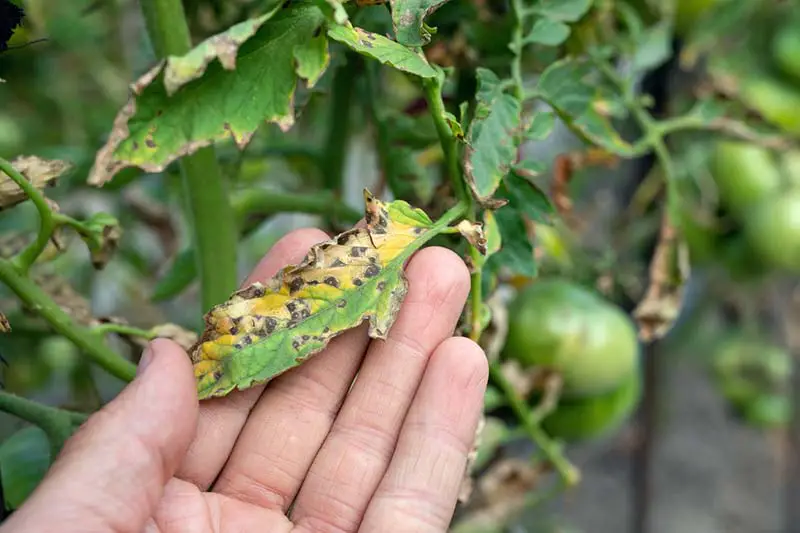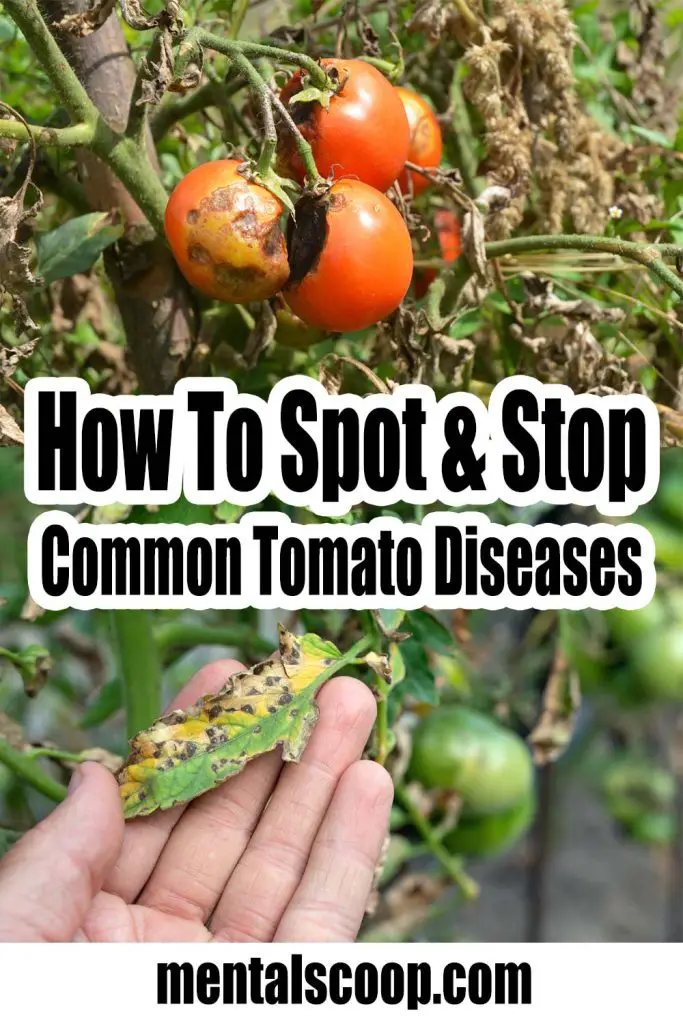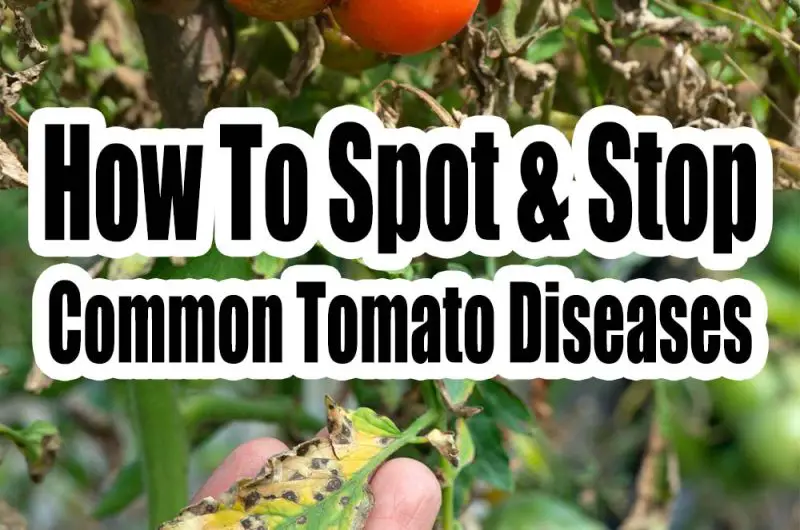How To Spot & Stop Common Tomato Diseases

Tomatoes are a popular vegetable grown in home gardens and on farms worldwide. They are relatively easy to grow and can produce abundant harvests. However, like any other plant, tomatoes are susceptible to diseases that can reduce yields and even kill plants. In this article, we will discuss some common tomato diseases and how to prevent them.
Early Blight
How To Spot Early Blight
Early blight is a fungal disease that commonly affects tomato plants. The disease causes brown spots to appear on the lower leaves, which can then spread to the upper leaves and stems. Here are some signs to look for to spot early blight:
Brown spots on leaves: Early blight typically starts on the lower leaves of the tomato plant. Look for brown spots that are irregularly shaped and have a target-like appearance. The spots usually have a yellow halo around them.
Yellowing leaves: Infected leaves may also turn yellow before they develop brown spots. The yellowing usually starts at the edges of the leaves and spreads inward.
Leaf drop: As the disease progresses, infected leaves may drop from the plant prematurely. This can cause the plant to become weakened and may reduce fruit production.
Stem cankers: Early blight can also cause dark, sunken lesions on the stems of the tomato plant. These cankers can girdle the stem and cause the plant to wilt and die.
If you notice these symptoms on your tomato plants, it is important to take action to prevent the disease from spreading. Remove infected leaves as soon as possible, and avoid handling the plants when they are wet, as this can spread the fungus. Water the plants at the base rather than from above, as this can help keep the foliage dry. Additionally, you can apply fungicides to help control the disease. Be sure to read and follow the label instructions carefully. With proper management, you can reduce the impact of early blight and protect your tomato plants from further damage.
How To Stop Early Blight
Early blight is a common fungal disease that can affect tomato plants, but there are steps you can take to stop it from spreading and damaging your plants. Here are some strategies for controlling early blight:
Remove infected leaves: Early blight typically starts on the lower leaves of the tomato plant, so if you notice any leaves with brown spots, remove them immediately. This will help prevent the disease from spreading to the upper leaves and stems. Be sure to dispose of the infected leaves in a sealed plastic bag and do not compost them.
Water at the base: Avoid watering the foliage of the tomato plant as this can encourage the spread of fungal spores. Instead, water the plant at the base, close to the soil. Use a soaker hose or drip irrigation system to deliver water directly to the roots.
Space plants properly: Plant your tomato plants with enough space between them to allow for good air circulation. This will help prevent the buildup of moisture, which can encourage fungal growth.
Apply fungicides: If you are experiencing a severe outbreak of early blight, you may need to use a fungicide to control the disease. Look for products that contain chlorothalonil, copper, or mancozeb, and follow the label instructions carefully. Be sure to wear protective gear, such as gloves and a mask, when applying fungicides.
Plant resistant varieties: Some tomato varieties are more resistant to early blight than others. Look for varieties that have been bred for resistance to this disease, such as ‘Iron Lady’ or ‘Defiant.’ Additionally, you can rotate your crops every year to help prevent the buildup of fungal spores in the soil.
Late Blight
How To Spot Late Blight
Late blight is a serious fungal disease that can affect tomato plants, as well as other plants in the nightshade family, such as potatoes. The disease can cause rapid and devastating damage to your plants, so it is important to know how to spot it early. Here are some signs to look for:
Dark, water-soaked spots on leaves: Late blight typically starts on the lower leaves of the tomato plant and causes dark, water-soaked spots to appear. The spots may be irregularly shaped and have a fuzzy or moldy appearance. As the disease progresses, the spots can grow larger and may turn brown or black.
White, fuzzy growth on undersides of leaves: Late blight can produce a white, fuzzy growth on the undersides of infected leaves. This growth is made up of spores that can spread the disease to other plants.
Stem lesions: Late blight can also cause dark, sunken lesions on the stems of the tomato plant. These cankers can girdle the stem and cause the plant to wilt and die.
Fruit rot: In advanced stages of the disease, late blight can cause fruit rot. Infected fruits may have a greasy appearance and can quickly become soft and watery.
How To Stop Late Blight
Late blight is a serious fungal disease that can quickly destroy tomato plants, so it is important to take immediate action to control the disease. Here are some strategies for stopping late blight:
Remove infected plants: If you have one or more tomato plants with late blight, remove them from your garden immediately. Do not compost them, as this can spread the disease. Instead, dispose of them in a sealed plastic bag and send them to the landfill.
Apply fungicides: If you have a severe outbreak of late blight, you may need to use fungicides to control the disease. Look for products that contain chlorothalonil or copper, and follow the label instructions carefully. Be sure to wear protective gear, such as gloves and a mask, when applying fungicides.
Water at the base: Late blight spreads rapidly in wet conditions, so it is important to water your tomato plants at the base, close to the soil. Avoid watering the foliage of the plants, as this can encourage the spread of fungal spores.
Plant resistant varieties: Some tomato varieties are more resistant to late blight than others. Look for varieties that have been bred for resistance to this disease, such as ‘Legend’ or ‘Mountain Magic.’ Additionally, you can rotate your crops every year to help prevent the buildup of fungal spores in the soil.
Monitor your plants regularly: Keep an eye on your tomato plants and watch for any signs of late blight. If you notice any symptoms, take action immediately to control the disease before it spreads to other plants in your garden.
By following these strategies, you can help stop late blight from damaging your tomato plants and reduce the need for fungicides. Remember to monitor your plants regularly, and take action quickly if you notice any signs of disease.
Verticillium Wilt
How To Spot Verticillium Wilt
Verticillium wilt is a fungal disease that affects many plants, including tomato plants. Here are some signs to look for to spot Verticillium wilt:
Yellowing leaves: The first sign of Verticillium wilt is usually yellowing of the leaves, starting with the lower leaves and moving up the plant. The yellowing may be V-shaped, with the point of the V at the outer edge of the leaf.
Wilting: As the disease progresses, the leaves of the tomato plant may wilt and become crispy. The plant may also develop a general decline in growth, and the fruit may be small and of poor quality.
Brown discoloration of stems: Verticillium wilt can cause brown discoloration of the stems of the tomato plant. This discoloration may be visible when you cut into the stem.
White fungal growth: In some cases, you may see white fungal growth on the stem of the tomato plant. This is a sign that the plant is infected with Verticillium wilt.
It is important to note that these symptoms can also be caused by other diseases or environmental stressors, so it is best to have a positive diagnosis before taking action. You can have your plants tested by a professional lab to confirm whether or not they have Verticillium wilt.
How To Stop Verticillium Wilt
Unfortunately, once Verticillium wilt has infected your tomato plants, there is no cure. However, there are steps you can take to manage the disease and prevent its spread:
Remove infected plants: As soon as you notice the symptoms of Verticillium wilt, remove infected plants immediately. Do not compost them, as this can spread the disease. Instead, dispose of them in the trash.
Rotate your crops: Do not plant tomatoes or other susceptible plants in the same location for at least three years. This will help prevent the buildup of fungal spores in the soil.
Practice good garden hygiene: Keep your garden free of debris and weeds, as they can harbor fungal spores. Also, avoid working in your garden when the plants are wet, as this can spread the spores.
Use resistant varieties: Some tomato varieties are more resistant to Verticillium wilt than others. Look for varieties that have been bred for resistance to this disease, such as ‘Defiant’ or ‘Iron Lady.’
Amend your soil: If you have had problems with Verticillium wilt in the past, consider amending your soil with compost or other organic matter. This can improve the health of your soil and make it less hospitable to fungal spores.
Use fungicides: While fungicides cannot cure Verticillium wilt, they can help prevent the disease from spreading. Look for products that contain copper or chlorothalonil, and follow the label instructions carefully.
By following these strategies, you can help manage Verticillium wilt in your tomato plants and prevent its spread to other plants in your garden. Remember to remove infected plants immediately, rotate your crops, practice good garden hygiene, use resistant varieties, amend your soil, and consider using fungicides to prevent the spread of the disease.
Fusarium Wilt
How To Spot Fusarium Wilt
Fusarium wilt is a fungal disease that affects many plants, including tomato plants. Here are some signs to look for to spot Fusarium wilt:
Yellowing leaves: The first sign of Fusarium wilt is often yellowing of the lower leaves of the tomato plant, which then progresses upward. The yellowing may be V-shaped, with the point of the V at the outer edge of the leaf.
Wilting: As the disease progresses, the leaves of the tomato plant may wilt and become crispy. The plant may also develop a general decline in growth, and the fruit may be small and of poor quality.
Brown discoloration of stems: Fusarium wilt can cause brown discoloration of the stem of the tomato plant. This discoloration may be visible when you cut into the stem.
Stunted growth: Infected plants may also exhibit stunted growth and reduced yield.
It is important to note that these symptoms can also be caused by other diseases or environmental stressors, so it is best to have a positive diagnosis before taking action. You can have your plants tested by a professional lab to confirm whether or not they have Fusarium wilt.
How To Stop Fusarium Wilt
Fusarium wilt is a challenging disease to control, but there are steps you can take to help manage it in your tomato plants:
Remove infected plants: If you have plants that are infected with Fusarium wilt, remove them immediately and dispose of them in the trash. Do not compost infected plants, as the fungus can survive and spread in the compost. Remove as much of the root system as possible to reduce the chance of the fungus spreading to nearby plants.
Improve soil health: Fusarium wilt can be more severe in soil that is low in organic matter, so adding compost or other organic matter to your soil can help improve soil health and reduce the severity of the disease.
Use resistant varieties: There are tomato varieties that are resistant to Fusarium wilt, so choosing resistant varieties can be an effective way to manage the disease. Look for varieties with the letters “F” or “FF” after the name, which indicates they are resistant to Fusarium wilt.
Rotate crops: Avoid planting tomatoes or other susceptible plants in the same area for at least two years. This can help reduce the amount of Fusarium spores in the soil and prevent the disease from spreading.
Use fungicides: Fungicides can be used to help manage Fusarium wilt, but they are not always effective. If you choose to use a fungicide, be sure to follow the instructions carefully and apply it at the right time to maximize its effectiveness.
Practice good garden hygiene: Keep your garden clean and free of debris to reduce the chance of fungal spores spreading. Water your plants at the base, not the foliage, to prevent the spread of spores.
Remember that preventing Fusarium wilt is always easier than treating it. By practicing good garden hygiene, using resistant varieties, and rotating your crops, you can reduce the chance of Fusarium wilt affecting your tomato plants.
Bacterial Spot
How To Spot Bacterial Spot
Bacterial spot is a disease that affects many types of plants, including tomatoes. Here are some signs to look for to spot bacterial spot in your tomato plants:
Lesions on leaves: The first sign of bacterial spot is often small, dark lesions on the leaves of the tomato plant. These lesions may start out as water-soaked spots and then turn dark brown or black. The lesions may be surrounded by a yellow halo.
Lesions on fruit: Bacterial spot can also cause lesions on the fruit of the tomato plant. These lesions may be small and dark, and they may be sunken into the fruit. The lesions can make the fruit unsuitable for eating.
Wilting: As the disease progresses, the tomato plant may wilt and become stunted in growth.
Leaf drop: Infected leaves may drop prematurely from the plant, leading to defoliation.
It is important to note that these symptoms can also be caused by other diseases or environmental stressors, so it is best to have a positive diagnosis before taking action. You can have your plants tested by a professional lab to confirm whether or not they have bacterial spot.
How To Stop Bacterial Spot
Managing bacterial spot in tomato plants can be difficult, but there are several steps you can take to help prevent and control the disease:
Plant resistant varieties: There are tomato varieties that are resistant to bacterial spot, so choosing resistant varieties can be an effective way to manage the disease. Look for varieties with the letters “Bs” after the name, which indicates they are resistant to bacterial spot.
Practice good garden hygiene: Keep your garden clean and free of debris to reduce the chance of bacterial spores spreading. Water your plants at the base, not the foliage, to prevent the spread of spores.
Rotate crops: Avoid planting tomatoes or other susceptible plants in the same area for at least two years. This can help reduce the amount of bacterial spores in the soil and prevent the disease from spreading.
Use copper-based fungicides: Copper-based fungicides can be effective in controlling bacterial spot, but they are not always successful. If you choose to use a fungicide, be sure to follow the instructions carefully and apply it at the right time to maximize its effectiveness.
Control insect vectors: Some insects, such as thrips and flea beetles, can spread bacterial spot from plant to plant. Controlling these insects can help prevent the spread of the disease.
Prune infected leaves and branches: Removing infected leaves and branches from the plant can help reduce the amount of bacteria in the plant and prevent the disease from spreading.
Remember that prevention is always easier than treatment when it comes to bacterial spot. By practicing good garden hygiene, using resistant varieties, and rotating your crops, you can reduce the chance of bacterial spot affecting your tomato plants. If you do have bacterial spot, it is important to remove infected plants and practice good garden hygiene to prevent the disease from spreading to other plants.
Tomato Mosaic Virus
How To Spot Tomato Mosaic Virus
Tomato mosaic virus is a common virus that affects tomato plants. Here are some signs to look for to spot the virus in your tomato plants:
Mottled leaves: The first sign of tomato mosaic virus is often mottled leaves, which appear to have light and dark green patches. These patches may be irregular and can cover the entire leaf surface.
Stunted growth: Tomato mosaic virus can cause stunted growth in tomato plants. Affected plants may be smaller than normal and may not produce as much fruit.
Yellowing leaves: As the disease progresses, leaves may turn yellow and then brown. Affected leaves may also curl and become distorted.
Reduced fruit quality: Tomato mosaic virus can affect the quality of the fruit produced by affected plants. The fruit may be smaller than normal and may have uneven coloring or other deformities.
Mosaic patterns on fruit: Tomato mosaic virus can cause mosaic patterns on the fruit of affected plants. These patterns may appear as light and dark green patches or as concentric circles.
It is important to note that these symptoms can also be caused by other diseases or environmental stressors, so it is best to have a positive diagnosis before taking action. You can have your plants tested by a professional lab to confirm whether or not they have tomato mosaic virus.
How To Stop Tomato Mosaic Virus
Unfortunately, once tomato plants are infected with the tomato mosaic virus, there is no cure. The best way to stop the spread of the virus is to remove and destroy the infected plants. Here are some steps you can take to prevent the spread of tomato mosaic virus:
Plant resistant varieties: There are some tomato varieties that are resistant to tomato mosaic virus. Look for varieties with the letters “TMV” after the name, which indicates they are resistant to the virus.
Practice good garden hygiene: Practice good garden hygiene by washing your hands thoroughly before handling plants, tools, and other garden materials. Use disinfectants to clean your tools and surfaces to prevent the spread of the virus.
Control insect vectors: The tomato mosaic virus can be spread by insects, such as aphids and whiteflies. Control these pests by using insecticidal soap or neem oil.
Avoid using tobacco products: The tomato mosaic virus is related to the tobacco mosaic virus, and it can be spread by tobacco products. Avoid smoking or using tobacco products in or around your garden.
Use certified disease-free seed: Use only certified disease-free seed when planting tomatoes. This can help reduce the risk of introducing the virus to your garden.
Remove infected plants: If you see signs of tomato mosaic virus in your plants, remove and destroy the infected plants immediately. Do not compost the infected plants, as the virus can survive in the compost and infect future plants.
Preventing the spread of tomato mosaic virus is important for the health of your garden. By practicing good garden hygiene, controlling insect vectors, and removing infected plants, you can help stop the spread of the virus and protect your tomato plants.
Powdery Mildew
How To Spot Powdery Mildew
Powdery mildew is a fungal disease that affects many plants, including tomatoes. Here are some signs to look for to spot powdery mildew in your tomato plants:
White powdery patches: The most common sign of powdery mildew is the appearance of white, powdery patches on the leaves and stems of tomato plants. These patches may start small and grow larger over time.
Distorted leaves: As the disease progresses, affected leaves may become distorted and appear crinkled or twisted. In severe cases, leaves may become yellow and eventually die.
Stunted growth: Powdery mildew can also cause stunted growth in tomato plants. Affected plants may be smaller than normal and may not produce as much fruit.
Infected fruit: In some cases, powdery mildew can infect the fruit of tomato plants. Affected fruit may have a powdery coating and may be deformed or smaller than normal.
Spots on the stem: Powdery mildew can also cause small, dark spots on the stems of tomato plants. These spots may be accompanied by the white powdery patches on the leaves.
It is important to note that these symptoms can also be caused by other diseases or environmental stressors, so it is best to have a positive diagnosis before taking action. You can have your plants tested by a professional lab to confirm whether or not they have powdery mildew.
How To Stop Powdery Mildew
If you have noticed signs of powdery mildew on your tomato plants, there are several steps you can take to stop the spread of the disease and protect your plants:
Remove infected leaves: As soon as you notice powdery mildew on your tomato plants, remove any infected leaves and dispose of them. This will help prevent the disease from spreading to other parts of the plant.
Improve air circulation: Powdery mildew thrives in humid conditions, so improving air circulation around your tomato plants can help prevent the disease. Prune your plants to allow for better air flow, and avoid overcrowding them.
Water properly: Water your tomato plants in the morning so that the leaves have time to dry before the evening. This can help prevent the growth of powdery mildew.
Apply fungicides: Fungicides can be used to help control powdery mildew. Look for products that contain potassium bicarbonate, neem oil, or sulfur, which are effective against powdery mildew.
Use organic remedies: You can also use natural remedies to control powdery mildew, such as a solution of baking soda and water or a mixture of milk and water. These remedies can be sprayed onto the leaves of affected plants to help control the disease.
Plant resistant varieties: There are some tomato varieties that are resistant to powdery mildew. Look for varieties with the letters “PM” after the name, which indicates they are resistant to the disease.
By taking these steps, you can help stop the spread of powdery mildew and protect your tomato plants from further damage.
Blossom End Rot
How To Spot Blossom End Rot
Blossom end rot is a common problem in tomato plants, and it can be identified by the following signs:
Brown or black spot at the bottom of the fruit: This is the most obvious sign of blossom end rot. The spot usually starts small and darkens over time, becoming larger and more noticeable.
Soft, sunken area on the fruit: The spot may also feel soft or mushy to the touch, and it may appear sunken inwards.
No signs of pests or diseases: Blossom end rot is caused by a calcium deficiency in the plant, so there will be no visible signs of pests or diseases causing the problem.
Occurs during periods of rapid growth: Blossom end rot is more likely to occur during periods of rapid growth, such as when the plant is producing a lot of fruit.
Affects the first fruits of the season: Blossom end rot tends to affect the first fruits of the season more often than later fruits.
If you notice these signs on your tomato plants, it’s important to take action to prevent further damage.
Note: It’s important to differentiate blossom end rot from other conditions that may look similar, such as sunscald or early blight. To ensure proper diagnosis, consult with a gardening expert or take a sample to a local plant clinic.
How To Stop Blossom End Rot
Blossom end rot is caused by a calcium deficiency in the plant, so taking steps to improve calcium uptake can help prevent the problem from occurring. Here are some ways to stop blossom end rot in your tomato plants:
Maintain consistent soil moisture: Inconsistent watering can interfere with calcium uptake in the plant. Be sure to water your plants regularly and deeply, especially during hot and dry weather.
Test your soil: Conduct a soil test to determine if your soil is lacking in calcium. If the soil is deficient in calcium, add a calcium-rich fertilizer or soil amendment to the soil.
Add organic matter: Adding organic matter to your soil can help improve calcium uptake by the plant. Incorporate compost, bone meal, or other organic matter into the soil around your plants.
Use mulch: Mulching around the base of your plants can help regulate soil moisture and temperature, which can improve calcium uptake. Use organic mulch such as straw, leaves, or grass clippings.
Use calcium sprays: Calcium sprays can be used to provide a quick source of calcium to the plant. Look for calcium chloride or calcium nitrate sprays at your local garden center.
By taking these steps, you can help prevent blossom end rot from occurring in your tomato plants. It’s also important to monitor your plants regularly and remove any affected fruits to prevent the disease from spreading.

More interesting articles you may be interested in reading:
How To Remove A Tree Stump Painlessly
10 Vital Home Maintenance Tasks You’ll Regret If You Forget
See How Much Propane Is Left In A Tank With No Gauge
Thanks for reading and be sure to share this info with your friends using the socia
Thanks for reading and be sure to share this info with your friends using the social share buttons below.
Talking about social stuff, consider liking our Facebook page to keep up to date with our articles. Check out our other articles for more mental scoops!




